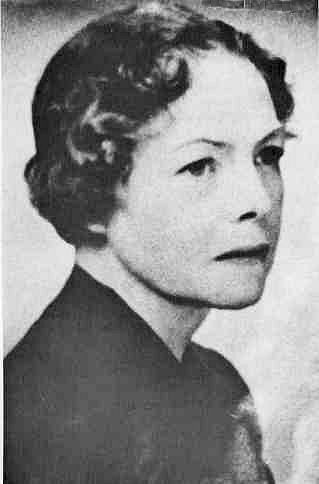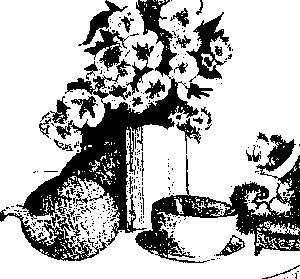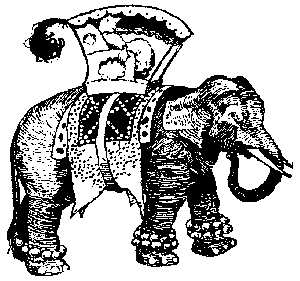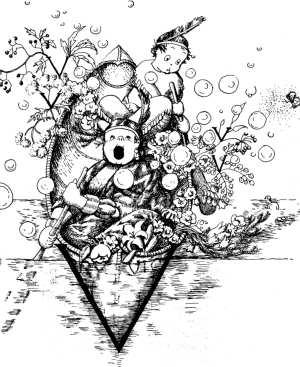Collecting Delaware Books
Anne Parrish
Contents
Biography

Anne Parrish (November 12, 1888 - September 5, 1957) was born in Colorado Springs, Colorado, and spent most of her girlhood there and in her grandmother's home in Claymont, Delaware. She wrote and illustrated children's books but is best known as a novelist. At least one of her novels was based on real scenes in Claymont.
Her parents were Thomas C. Parrish and Anne Lodge Parrish of Claymont. (She was not the daughter of famed artist Maxfield Parrish as some standard references state. See Confusing Trail about biographical and bibliographical errors.) Her mother's family had lived and farmed in Claymont for more than a century. A description of early life there is found in the privately printed We Were Three, 1945, by the mother, Anne Lodge Parrish.
The mother was a recognized artist. Anna T. Lincoln (in Wilmington, Delaware, Three Centuries Under Four Flags, 1609-1937) lists her as one of several artists who illustrated the Delaware scene between 1870 and 1900. She knew Felix O. C. Darley and contributed a collection of his sketches and published illustrations as well as her reminiscences of him to the Historical Society of Delaware in 1943. She died about 1946.
Anne Parrish says she "was slightly educated in private schools in Colorado and Delaware." One of these was the Misses Hebb's School in Wilmington. Later she "studied painting in Philadelphia, more because my mother and father were painters than because I was one." The school was the Philadelphia School of Design for Women.
Not willing to meet the demands of life as an artist, she turned to writing. Her first romantic novel appeared in 1923, and 14 more were published over the next 35 years. Also, she and her younger brother Dillwyn, her only sibling, created two children's books, dividing equally the writing and illustrating work, and one book of literary sketches. She wrote and illustrated two more juveniles on her own.
(Dillwyn, who was born in 1894, wrote several novels on his own. He married novelist, essayist, and food writer M. F. K. Fisher, a second marriage for both. He died in 1941 and was probably the second man described in Fisher's The Gastronomical Me. He is also said to have co-authored a book with Fisher under the pseudonym Veronica Berne.)
Anne Parrish married industrialist Charles Albert Corliss in 1915, who died in 1936. In 1938, she married Josiah Titzell, who died in 1943. Titzell wrote poetry under his own name and was a novelist, using the name "Frederick Lambeck."
In adult life, Parrish lived in New York and Connecticut. She traveled extensively and once said, "I think I have been in every country except Australia and Russia." Despite her residence and travel, she maintained her Delaware contacts, even after her mother's death. She corresponded with Christopher L. Ward, and wrote at least 20 letters to Gertrude Brinckle which have been preserved. In 1946, she spoke before the Historical Society of Delaware on Harriet Tubman.
Described as "pronounced blonde and very attractive," she appears to be a classic 1930-era beauty in photographs. She was a wealthy woman when she died of a cerebral hemorrhage in Danbury, Connecticut, in 1957.
Her Books
Anne Parrish's novels often deal with day-to-day relationships of ordinary people, or at least ordinary people as she understood them. There are no poor people among her characters, and many of them are artistic or literary. With a few notable exceptions, her characters are women.
Quietly stated satire is her stock in trade. Various characters are just a little too snobbish, gushy, stupid, self-indulgent, or romantic to be true. A critic said her novels would have been warmer if Parrish did not so obviously dislike her characters. Few of her novels are happy stories.
However, the stories are all carefully plotted and well told. Dialog provides a great deal of the forward motion, though there are nice narrative passages. And she assumes her readers are perceptive. In Loads of Love, for instance, she does not tell us that Edward is a bad writer who will not succeed as a novelist: she merely has Edward read a paragraph of his writing aloud.
Her children's books were described in detail in Collecting Delaware Books volume 2, number 1. (Republished below on this Web page.)
Few of Parrish's novels command a high price, even signed first editions. A complete set could be accumulated for between $100 and $200 by the patient collector. Her illustrated children's books sometimes command $25 to $50 from collectors of juveniles.
Annotated Checklist
Pocketful of Poses, 1923. Anne Parrish's first novel.
Knee-High to a Grasshopper, 1923. Juvenile written and illustrated with D. Parrish. Nominated for the Newbery Medal.
Semi-Attached, 1924.
The Dream Coach, 1924. Juvenile written and illustrated with D. Parrish. Nominated for the Newbery Medal.
Lustres, 1924. Collection of sketches written with D. Parrish. Parrish said she and her brother would rather forget this book.
The Perennial Bachelor, 1925. Won the Harper Prize Novel Contest. On the dust jacket the author says, "[The book] is laid in Delaware, and to a large extent in my old home [in Claymont], where my mother still lives, and which has been in the family for many years. Of course, some of the scene is imaginary, as all of the people are, but a good deal of it is real." The story traces American family life from 1850 to 1925, telling of people who often sacrificed happiness for the appearance of good breeding and family pride.
To-morrow Morning, 1926.
All Kneeling, 1928. Parrish's only best-seller. The story of a seemingly sweet, sensitive women novelist whose every action was selfish. It moves from staid Philadelphia to Bohemian circles in New York.
The Methodist Faun, 1929. Her first novel with a male protagonist. Parrish sketches Pine Hills with its Methodist code of behavior and Clifford Hunter whose every situation is at conflict with his temperament.
Floating Island, 1930. Juvenile. Includes 12 black-and-white illustrations by Parrish.
Loads of Love, 1932. Well-to-do but homely and uncouth Bessie gathers a crowd of other young people at her rustic summer home, leading to romantic complications.
Sea Level, 1934. The gently satirical story of Americans abroad. It opens with a complete crew and passenger list of the S.S. Aurora on an around-the-world cruise.
Golden Wedding, 1936.
Mr. Despondency's Daughter, 1938.
Pray for a Tomorrow, 1941.
Poor Child, 1945.
A Clouded Star, 1948. Novel based on the life of slave leader Harriet Tubman.
The Story of Appleby Capple, 1950. A juvenile, dedicated to her deceased younger brother Dillwyn and based on an alphabet game he and Anne had played as children. One critic said of the book, "It is the distillation of a most charming mind, amusing itself with weaving together its over-acute observations of much of the world's loveliness into a witty dream-search with a beautiful happy ending." Nominated for the Newbery Medal.
And Have Not Love, 1954. The story of pampered Clara Le Strange, whose insatiable appetite for excitement and enjoyment blights three generations.
The Lucky One, 1958. Apparently published after her death.
— JPR
Confusing Trail
Volume 115 of Gale's Contemporary Authors, a reference available in most public libraries, incorrectly says Anne Parrish was the daughter of famed painter and illustrator Maxfield Parrish and Anne Lodge Parrish. The mother's name is correct, but Anne Parrish was only a distant cousin of Maxfield. They had common great-grandparents, Dr. Joseph and Susanna (Cox) Parrish. (See the genealogy The Parrish Family, 1935, compiled by Scott Lee Boyd.)
Researching the life of Anne Parrish (1888-1957) is fraught with such confusion for at least four reasons.
First, she had the same first name as her mother, Anne Lodge Parrish (Mrs. Thomas C. Parrish), who died about 1946. Library catalogers confuse the two, even at times putting Anne Parrish's birth and death dates on a citation to her mother's work. The mother exercised her right to sign her work "Anne Parrish," even after the daughter became famous.
Second there were other Ann or Anne Parrishs of historical note in the 18th and 19th centuries.
Third, there were a great many Parrish's in the Wilmington-Philadelphia area, with up to 17 children in a single family. Family first names were used repeatedly, including "Dillwyn," which was Anne Parrish's brother's name. For example, Maxfield named his first son John Dillwyn Parrish, born in 1904. This son has been incorrectly stated to have been the second husband of M. F. K. Fisher, but death dates indicate her husband was Anne Parrish's brother.
Fourth, many Parrish men and women were financially well off and had literary or artistic talent.
Anyone studying Anne Parrish's life is advised to be suspicious of every citation, reference, and genealogical statement. Even Parrish's second husband's first name is listed incorrectly as Joseph (it was Josiah) in one biographical dictionary. Do not assume that the catalogers or reference book writers checked their facts, because obviously many did not.
We Were Three
A good example of Parrish name confusion is Anne Lodge Parrish's charming 57-page book We Were Three, 1945, describing her childhood on a farm in Claymont. Only six copies were printed. The book is frequently incorrectly attributed to the daughter, Anne Parrish.
There is much internal evidence that the mother was the author. Most telling is her description of artist Felix Darley reading poetry at her parent's tin wedding anniversary. Darley died in 1888, the year daughter Anne Parrish was born.
But the clincher is the inscription in one of the three copies of this book held by the Historical Society of Delaware, which reads as follows.
"I the author of this little book -- of which there are only six copies in the world give it to the Historical Society of Delaware in memory of my uncle Chief Justice Charles B. Lore of Wilmington Dela. a truly great and good man. [signed] Anne Parrish ne� Lodge."
Anne and Brother Dillwyn as Illustrators



Anne Parrish is well-known as a novelist. Her brother Dillwyn was not as successful but had several books published. Both grew up in Claymont, Delaware. It is not commonly known that they started their careers writing and illustrating children's books.
Knee-High to a Grasshopper by Anne and Dillwyn Parrish was published in 1923 by the Macmillan Company of New York, probably the first important published work by either. It includes 209 pages of stories and occasional poetry decorated with 49 black-and-white drawings. The drawings are in pen and wash. The line work is delicate. Sizes run from vignette to full page.
There is nothing in the title page, text, or drawings to indicate the division of work between the siblings. However, Anne has always seemed to be the stronger, and, even 25 years later, she referred to Dillwyn as "little brother."
The first book ended with a poem. The next book started with the same poem, which gave the book its title. The Dream Coach was published in 1923 by Macmillan. It had 143 pages and 45 blackand-white illustrations and tailpieces. In contrast to the first book, the line work is strong and washes are replaced with solid blacks.
Both these early books are nicely printed in the style of the day. The title pages remind one of Howard Pyle and Walter Crane. Each has striking endpapers. Knee-High to a Grasshopper has black-and-white illustrations grouped in blocks on the endpapers. The Dream Coach has a spray of flowers in solid black, yellow, and red on white endpapers.
After Dillwyn's death and near the end of her writing career, Anne wrote and illustrated another children's book. The Story of Appleby Capple was published in 1950 by Harper & Brothers, New York. The dedication is a poem to Dillwyn. The book is a rambling 184-page narrative supporting 64 black-and-white drawings that work in the letters of the alphabet. Mice, rabbits, caterpillars, and butterflies make their way with people through this book, just as they do in the previous two. Appleby Capple and the letter "A" cavort in black, green, and red on the endpapers.
The early books were 5½ by 8 inches. This one is 8½ by 12 inches, and many of the drawings are full-page. Again, the style is quite different and very much of the fifties. Indeed, in the three books, the style changes almost from Beatrix Potter's to Tasha Tudor's, though the excellence of these artists is not rivaled.
These three books are easy to find. Like most children's books they are hard to find in fine condition. Dust jackets are even rarer. However, the books cast an interesting light on this talented brother and sister.
Note that Dillwyn Parrish was the second husband of famed American food writer M.F.K. Fisher. Her biographers identify him as a painter. Dillwyn's death after a long illness figures heavily in three of Fisher's books. — JPR